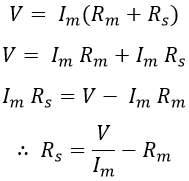In the last article, we have seen about range extension of ammeters. The range of ammeters can be extended by using a shunt or current transformer. Now let us learn about the extension of the measuring range of voltmeters.
Due to difficulty in measuring high voltages with normal voltmeters, it is, therefore, necessary to bring those high values to normal values that can be measurable by voltmeters. This process is called the extension of range of voltmeter. In this, an external device is connected to the measuring instrument to increase the measuring range of the instrument.
Similar to the ammeter, the range of the voltmeter can be extended by using a multiplier or a potential transformer. Multipliers can be used for both ac and dc voltmeters, while potential transformers can be used for only ac voltmeters.
Extension of Range of Voltmeter Using Multiplier :
A multiplier is basically a resistor connected in series with the voltmeter as shown below. The main function of the multiplier is to limit the flow of current through the voltmeter in such a way that the deflection of the pointer should not exceed the full-scale deflection.
It must ensure that the voltmeter should be connected in parallel or across two points, to measure the potential difference.
Let,- Rm = Internal resistance of the meter
- Rs = Resistance of multiplier
- Im = Full-scale deflection current of meter
- V = Voltage being measured
- Vm = Full deflection voltage of the meter
From the above figure,
The multiplying factor of the multiplier is the ratio of extended voltage range to be measured V to the actual sustainable voltage by the voltmeter Vm. If the sustainable voltage drop of the meter Vm = Im Rm. Then multiplying factor m is,
Hence, to extend a voltmeter range for m times. The resistance of the multiplier required is (m-1) × resistance of the meter.
Essential Requirements of Multipliers :
The construction of multiplier should meet the following requirements,- The resistance of the multiplier should be time-invariant.
- The temperature coefficient of resistance should be small.
- They should be non-inductively wound for ac meters.
In practice, the multipliers are made up of materials that have negligible temperature coefficients like manganin and constantan. These also reduce the errors due to temperature changes.
Multirange Voltmeter :
To increase the range of the voltmeter a series resistor called a multiplier is connected in series to limit the meter current. The range of the voltmeter is the product of the multiplier resistance and the maximum meter current (i.e., Rm × Im). So, to increase the range of voltmeter, multiplier resistance has to be increased. Hence, multiple voltage ranges can be obtained by using individual multipliers as shown below.
The range of voltmeter when switch is at position 1 is V1 = Im(R1 + Rm) at position 2, V2 = Im(R2 + Rm) at position 3, V3 = Im(R3 + Rm) and so on. Since R1 < R2 < R3 < and so on. Therefore V1 < V2 < V3 < and so on. Hence, we obtain different voltage ranges by using a multirange voltmeter.
Extension of Range of Voltmeter Using Potential Transformer :
It is not convenient to use multipliers to extend the range of the voltmeter for measuring the voltages in the order of kilo-volts. Since, as the voltage increases the power consumed by the multiplier increases. Also, it is difficult to provide insulation of multipliers against leakage currents and reduction of shunt capacitive currents. Therefore, the multiplier cannot be used in voltmeters for measuring voltages more than 1000V.
This drawback can be overcome by using a potential transformer. A potential transformer is an instrument transformer that steps down the voltage in a known ratio. The below shows the potential transformer whose secondary is connected to a voltmeter.
Generally, the secondary of the potential transformers is rated to 0-110V irrespective of the primary voltage. These low voltages from the secondary side are given to the normal voltmeters and can be measured easily. But the potential transformers can be used only for ac measurements e.g. moving-iron type voltmeters.





